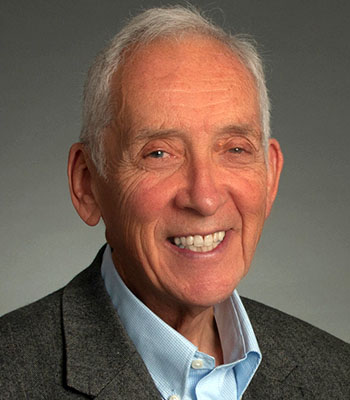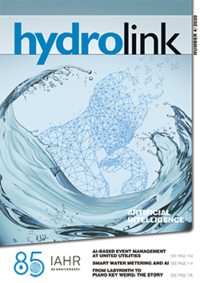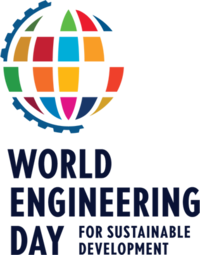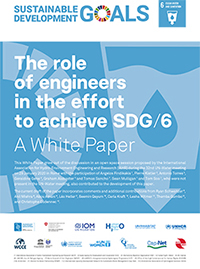[IAHR Talks] Interview with Angelos Findikakis. Focus on sustainable development
#IAHRTalks
 Angelos Findikakis, Bechtel Fellow, Bechtel Corporation, and Adjunct Professor, Stanford University, USA, is chair of the IAHR working group on Sustainable Development Goals and vice-chair of the IAHR working group on Global Water Security. He recounts some of the highlights of his career and shares his thoughts on the role and challenges of technology in the engineering profession, the importance of bridging the gap between science and industry, and the latest updates from the IAHR in the area of sustainable development.
Angelos Findikakis, Bechtel Fellow, Bechtel Corporation, and Adjunct Professor, Stanford University, USA, is chair of the IAHR working group on Sustainable Development Goals and vice-chair of the IAHR working group on Global Water Security. He recounts some of the highlights of his career and shares his thoughts on the role and challenges of technology in the engineering profession, the importance of bridging the gap between science and industry, and the latest updates from the IAHR in the area of sustainable development.
David Ferras, vice-chair of the IAHR technical committee on Education and Professional Development, interviews Angelos Findikakis.
Could you describe in a few words how you got started in your career?
During my undergraduate studies back in Greece I visited the construction site of a large dam for a hydropower project (Kremasta Dam) and I was very impressed by what I saw; at that point I thought that it would be exciting to work on this type of project as an engineer. Coincidentally, when I graduated, I came across a position in a Canadian company to carry out feasibility and engineering studies for water resources development in their office in Greece. After some time, I realized that my basic knowledge of water development projects was quite limited, so I decided to come to the USA for graduate studies. What I found there was quite different; the programme I enrolled in at Stanford University placed great emphasis on the environmental aspects of water projects, which broadened my interests from the strictly engineering aspects to the broader environmental issues of water development. Since then I have been involved in the industry supporting water development and dealing with hydrology and hydraulics problems for different infrastructure projects, but always with an interest on the water management and environmental impact sides. In parallel, I also have been an adjunct professor at Stanford University teaching on the topic of water resources management. Nowadays, my interests are mostly in the water-related global challenges, as expressed in the Sustainable Development Goals.
How has your field of study changed in the time you have been working in it?
There are external changes that we cannot neglect such as the digital revolution in the second half of the twentieth century that led to the information age in which we live now. To appreciate how far we have come in the last fifty years I can tell you that when I started my undergraduate studies in the 1960s at the National Technical University of Athens we were using slide-rules instead of calculators! The development of powerful computers has had a major impact in our field, making it possible to solve complex equations by means of numerical models. Technology has played a crucial role in accelerating advancements in our field of research, pushing forward and even pulling along scientific development. If we take hydraulics as an example, it is not only about the developments that made very complex computations possible, but also about those in sensors and optical methods that enable capturing and measuring flow patterns with high accuracy. Another example is the development and use of drones for hydro-environment projects which enable the type of data acquisition that was prohibitively expensive and even difficult to imagine ten years ago. Consequently, nowadays professionals working on different aspects of hydro-environment engineering must have knowledge of special topics far beyond classic hydraulic engineering science. Big data, artificial intelligence, deep learning, remote sensing, photogrammetry, advanced flow sensors, and drone technologies are some of these subjects.
In this line between fundamental and applied research this statement brings you closer to the latter. Where would you place IAHR as an association?
The work of IAHR definitely lies somewhere in between fundamental and applied research. On the one hand, there are researchers in IAHR focusing on the fundamentals of fluid mechanics, while on the other hand there are technical committees that are addressing specific systems, like fluvial hydraulics, coastal and maritime hydraulics, ecohydraulics, etc. Maybe what is missing is communicating to a broader audience the value of our research and the areas of its applicability. This is probably caused by the fact that IAHR members are mainly researchers in academia, and professionals from industry are a minority. IAHR is, essentially, a research association, however I believe we should work on having a better balance between academia and industry in our membership. If you are about to build an engineering project in a natural system you first need to understand that natural system itself to see how it would be impacted by the project and the other way around, how the system would impact the project. This is a two-way and a win-win interaction between researchers and practitioners. IAHR provides an excellent framework to make this possible.
What is your vision for Hydrolink? Bridging science and engineering, bringing together researchers in the field of hydro-environment, dissemination beyond IAHR members?
 I think it is all of that. My vision is to showcase how specific research is applied to solve a problem in the field of hydro-environment. IAHR covers a broad range of researchers working in varied fields, from the basics of fluid mechanics to natural systems like rivers, coastal areas, glaciers, etc. Ultimately our research is driven by engineering problems. The role of Hydrolink is to show this connection, highlighting the application of research and advances in hydraulic engineering in solving actual problems by describing different cases. There are plenty of examples from around the world. Recently we have had three Hydrolink issues on reservoir sedimentation, which is a big problem because of the loss of water storage capacity. We published issues on groundwater, coastal infrastructure, and hydraulic transients. Taking as an example the latter, what we try to achieve is to go beyond the esoteric aspects of modelling transient phenomena and focus instead on the importance of the subject and the impact of hydraulic transients if they are not properly considered in engineering designs, which can lead to significant failures. An example of this is the 2009 catastrophic accident of the largest hydropower station in Russia, the Sayano-Shushenskaya power plant, that resulted in the death of tens of workers and extensive damage to the station, and where hydraulic transients phenomena were at the heart of the cause of the accident.
I think it is all of that. My vision is to showcase how specific research is applied to solve a problem in the field of hydro-environment. IAHR covers a broad range of researchers working in varied fields, from the basics of fluid mechanics to natural systems like rivers, coastal areas, glaciers, etc. Ultimately our research is driven by engineering problems. The role of Hydrolink is to show this connection, highlighting the application of research and advances in hydraulic engineering in solving actual problems by describing different cases. There are plenty of examples from around the world. Recently we have had three Hydrolink issues on reservoir sedimentation, which is a big problem because of the loss of water storage capacity. We published issues on groundwater, coastal infrastructure, and hydraulic transients. Taking as an example the latter, what we try to achieve is to go beyond the esoteric aspects of modelling transient phenomena and focus instead on the importance of the subject and the impact of hydraulic transients if they are not properly considered in engineering designs, which can lead to significant failures. An example of this is the 2009 catastrophic accident of the largest hydropower station in Russia, the Sayano-Shushenskaya power plant, that resulted in the death of tens of workers and extensive damage to the station, and where hydraulic transients phenomena were at the heart of the cause of the accident.
In November 2019, during the UNESCO General Conference, 4 March was proclaimed to be World Engineering Day for Sustainable Development. What do you think of having specific "World Days" devoted to UN international concerns? What is your opinion about the relatively new celebration on 4 March?
 The United Nations General Assembly has designated several "International Days" in an effort to draw attention to different topics or issues. This gives the opportunity to specific groups and communities to mobilize and organize events and activities that help raise awareness about the topic celebrated on a particular International Day. However, the large number of such days makes it more challenging to draw the attention of the general public to the issue at hand, especially since in some cases the same calendar day has been designated as International Day for more than one topic. We should recognize though that some such days are well established. An example is World Water Day on 22 March, the day that every year UN-Water releases a report on a specific aspect of world water development and the mass media report on it. World Engineering Day for Sustainable Development provides the opportunity of informing the general public of how engineering has evolved over the last few decades and that the work that engineers do today and the way they do it supports sustainable development.
The United Nations General Assembly has designated several "International Days" in an effort to draw attention to different topics or issues. This gives the opportunity to specific groups and communities to mobilize and organize events and activities that help raise awareness about the topic celebrated on a particular International Day. However, the large number of such days makes it more challenging to draw the attention of the general public to the issue at hand, especially since in some cases the same calendar day has been designated as International Day for more than one topic. We should recognize though that some such days are well established. An example is World Water Day on 22 March, the day that every year UN-Water releases a report on a specific aspect of world water development and the mass media report on it. World Engineering Day for Sustainable Development provides the opportunity of informing the general public of how engineering has evolved over the last few decades and that the work that engineers do today and the way they do it supports sustainable development.
Could you give us an update on the progress of the IAHR Working Group on Sustainable Development Goals in 2020 and on the agenda highlights for 2021?
 The IAHR working group on Sustainable Development Goals supports different activities of UN-Water contributing to its annual World Water Development Report. Last year it also contributed to the development of a white paper on the role of engineers in the effort to achieve SDG 6, which was prepared in collaboration with representatives of several UN-Water partners and agencies.
The IAHR working group on Sustainable Development Goals supports different activities of UN-Water contributing to its annual World Water Development Report. Last year it also contributed to the development of a white paper on the role of engineers in the effort to achieve SDG 6, which was prepared in collaboration with representatives of several UN-Water partners and agencies.
In 2021 we are planning to continue supporting different UN-Water activities related to the SDGs and participate in the IAHR Forum in July.
Angelos Findikakis received his first degree in Civil Engineering in 1968 from the National Technical University of Athens, Greece. After working on water resources planning and development studies in Greece, he came to Stanford for graduate studies in 1973. Since 1980 he has been working for Bechtel Corporation in San Francisco. Over the years he has worked on a broad range of water studies in support of the permitting, design and construction of several industrial projects including civil infrastructure, power, mining, oil and gas, and waste storage facilities. As a Bechtel Fellow since 1998 he advises senior management on questions related to his expertise, participates in strategic planning, and helps disseminate new technical ideas and findings throughout the organization. His interests include water resources management and environmental flow and transport processes.
From 2013 until 2017 Angelos was a Member of the IAHR Council and from 2015 to 2017 he served as IAHR Vice-President; he also has edited the IAHR Hydrolink magazine since 2015. During the 38th IAHR World Congress in Panama, Angelos was awarded the IAHR Honorary Membership for his life-time contributions to the field of groundwater hydraulics and environmental issues and in recognition of his leadership of IAHR contributions to the UN Sustainability Development Goals, his Editorship of Hydrolink, and outstanding service to IAHR Technical Committees, Council and as Vice-President.
Our members, their views, knowledge, commitment, and experiences are what make IAHR a global leading association of hydro-environmental engineers, experts, researchers, and organisations. IAHR members’ voices and concerns guide the association on its continuing path towards a better future for water and the environment. Our members have a lot to contribute and we are listening to them so that we can put our collective voice forward.